A carbine and a pistol in the same chambering have much utility for personal defense, and 9mm Luger, 10mm Auto, and 45 ACP are chambered in many such combinations in semi-autos. If you live in a non-restrictive state, that’s great — enjoy. But if you live in a magazine-capacity-restricted state, or in one of the features-limited jurisdictions, then you may need a different duo, say, with a revolver and lever-action rifle. In those platforms, the 357 Magnum is perhaps the most popular combination. But some feel the 45 Colt has much merit.
In this ammo-testing installment, we will shoot a 45 Colt lever-action rifle and 45 Colt single-action revolver combination. The single-action revolver is in wide use across America because many simply like its feel and handling. Ditto that for carbines, which can be lightweight and short enough to handle inside the home or in the area immediately outside the home.
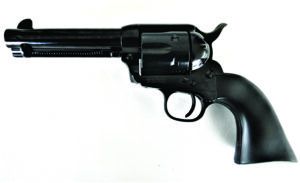
But we have to ask, is this combination a relic of the Old West, or is it still viable for personal defense? We believe both have their place inside the self-defense or home-defense perimeter, particularly the carbine. Also, a light, fast-handling carbine with the proper loads may be used for hunting deer and boar to at least 75 yards. The 45 Colt isn’t the most efficient cartridge ballistically, with a sizeable drop at extended ranges. But inside 100 yards, the cartridge hits hard.
Here, however, we tested the loads with personal defense in mind. This included carrying the revolver concealed or using it for home defense. A surprising number of armed citizens use the single action. As one shop owner told us, he had recently sold more Single Action Army–type revolvers in two months than he had the previous two years. They were the only big-bore handguns he could get, and some citizens wanted a 45.
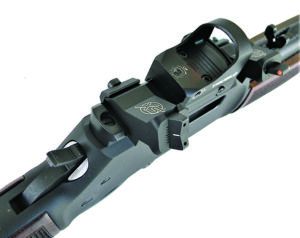
Safety is important. The single-action revolver is quite safe with the hammer down on an empty chamber, the proper ready mode for most of these revolvers. The carbine is much the same. Kept at home ready, chamber empty, it may be made be put into action with a fast arc of the lever. Leverage with a pistol-caliber carbine is much better than with a longer 30-30 WCF or 38-55 round. The action may be worked quickly for fast repeat shots. A homeowner with minimal training can have a high hit probability with the carbine.
To run our rounds through the ammo-testing trial, we used a Henry Big Boy carbine with a 20-inch barrel. At 8.5 pounds of gun and sights weight, recoil is modest for the 45 Colt. The lever action is smooth, and the rifle handles well. Magazine capacity is 10 rounds. The rifle averages $850 retail. The rater owning the rifle fitted the Henry Picatinny scope mount with a Tru-Glo red dot and XS backup sights intended for the AR-15 rifle. The front sight of the XS combo is a tritium orange dot. This makes for an excellent all-round go-anywhere do-anything defensive carbine.

On the handgun side, the Taylor’s & Co. Devil Anse 4¾-inch barrel single-action-army-type revolver is part of an extensive test of single-action revolvers we’re doing at Gun Tests. The revolver handles well, the action is smooth, and its accuracy is above average for the type.
We ran the cartridges through both guns, checking velocities, shooting for accuracy, and shooting the rounds into water jugs for penetration and expansion testing, as per our usual program. After reviewing these results and comparing them to previous testing of the 45 Colt, 10mm, or any other handgun cartridge, we find the 45 Colt’s combination of low recoil for the power and excellent wound ballistics attractive. Here’s how the rounds performed individually:
Buffalo Bore 225-Grain Hard-Cast Semi-Wadcutter Hollow Point
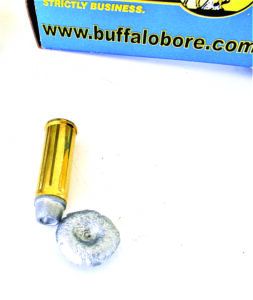 The Buffalo Bore heavy lead semi-wadcutter gas-check bullet is not a swaged lead bullet but a cast bullet. At 990 fps in the Devil Anse, the bullet penetrates 24 inches and expands to the greatest width of any of the bullets tested. While 0.84 inch is average in the revolver, one of the carbine loads went a wide 0.90 inch. This is easily the load with the greatest predicted wound potential. At 1109 fps from the carbine, expansion and penetration were virtually the same; however, the water jugs were blown around to a greater extent when fired in the carbine. This is a hard-hitting load that should prove effective against man and beast. Recoil is the greatest of the test, however, although it isn’t noticeably more difficult to fire in the carbine.
The Buffalo Bore heavy lead semi-wadcutter gas-check bullet is not a swaged lead bullet but a cast bullet. At 990 fps in the Devil Anse, the bullet penetrates 24 inches and expands to the greatest width of any of the bullets tested. While 0.84 inch is average in the revolver, one of the carbine loads went a wide 0.90 inch. This is easily the load with the greatest predicted wound potential. At 1109 fps from the carbine, expansion and penetration were virtually the same; however, the water jugs were blown around to a greater extent when fired in the carbine. This is a hard-hitting load that should prove effective against man and beast. Recoil is the greatest of the test, however, although it isn’t noticeably more difficult to fire in the carbine.
GUN TESTS GRADE (REVOLVER): A
GUN TESTS GRADE (CARBINE): A
Federal Champion 225-Grain Semi-Wadcutter Hollow Point C45LCA 45 Colt
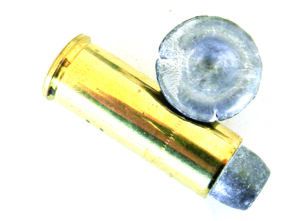 This is the classic revolver projectile, a lead semi-wadcutter hollow point. If the soft lead expands, that is good; if not, you have a flat nose and a cutting shoulder. In this case, the bullet penetrated 24 inches and expanded to 0.70 inch at 837 fps. Performance from the carbine at 1022 fps was a little different. The soft nose flattened and blew off, and the harder shank kept going. The shank was found at 22 inches. The bullet nose must have blown off in the first water jug, which was violently split open. Accuracy is OK. This is a good defense load. An advantage is modest recoil.
This is the classic revolver projectile, a lead semi-wadcutter hollow point. If the soft lead expands, that is good; if not, you have a flat nose and a cutting shoulder. In this case, the bullet penetrated 24 inches and expanded to 0.70 inch at 837 fps. Performance from the carbine at 1022 fps was a little different. The soft nose flattened and blew off, and the harder shank kept going. The shank was found at 22 inches. The bullet nose must have blown off in the first water jug, which was violently split open. Accuracy is OK. This is a good defense load. An advantage is modest recoil.
GUN TESTS GRADE (REVOLVER): A
GUN TESTS GRADE (CARBINE): B
Winchester Super-X 225-Grain Silvertip X45CSHP2 45 Colt
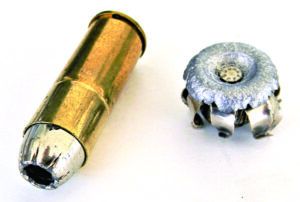
This is one of the oldest loadings out there. This current version performed better than in previous testing. At 798 fps in the revolver, recoil is modest. Just the same, penetration is an ideal 22 inches, with the plated jacketed hollow point expanding to a consistent 0.68 inch. From the rifle at 990 fps, there was a difference in both expansion and penetration. The bullet nose was smaller but had obviously expanded at some time because bullet fragments were scattered throughout the water jugs. The bullet came to rest at 26 inches when fired from the carbine. This is an acceptable loading, one that makes a good handgun and rifle loading for personal defense.
GUN TESTS GRADE (REVOLVER): A
GUN TESTS GRADE (CARBINE): A-
Winchester 225-Grain Defender S45XPDB 45 Colt
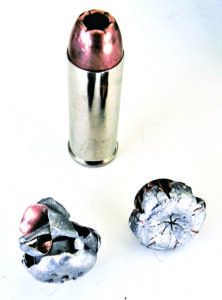
This is a modern bonded bullet now sold under the Defender line. Velocity is 810 fps in the revolver. At this velocity, the projectile penetrates 24 inches. Expansion is excellent at 0.66 inch. Clearly, this is a viable personal-defense load. When fired in the carbine at 1104 fps, the bullet looked much different. The expanded mushroom was peeled back, and expansion was actually less at 0.58 inch. Unlike the Silvertip, we did not find any fragments. The bullet penetrated the same when fired from the carbine at 24 inches. This is interesting performance. We seem to have had more rapid expansion, but penetration was the same.
GUN TESTS GRADE (REVOLVER): A
GUN TESTS GRADE (CARBINE): A
SIG Sauer Elite V-Crown 230-Grain JHP E45LC1 45 Colt
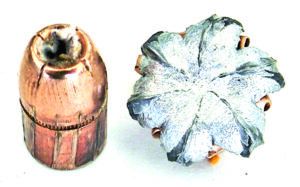
We have had good luck with the V-Crown design in 9mm and 45 ACP tests. In this case, the results were disappointing in the revolver. The 45 Colt load breaks 729 fps from the revolver. Muzzle blast and recoil, however, are as great as the other standard-pressure loads. This load penetrated 38 inches of water without expansion. When fired in the carbine, the results were dramatically different. At a modest 889 fps, the projectile penetrated 18 inches and expanded to a pretty plump mushroom of 0.82 inches. In the carbine, this is a mild, accurate and effective home-defense load. It way overpenetrates in the revolver and would not be a good choice for urban use because of that. For a home defense load in the carbine, this is an excellent choice.
GUN TESTS GRADE (REVOLVER): B-
GUN TESTS GRADE (CARBINE): B+
Remington HTP 230-Grain JHP No. 28562 45 Colt
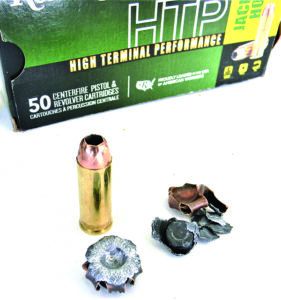 This load uses a 230-grain jacketed hollowpoint. Velocity is 857 fps in the revolver and 1040 fps in the rifle. In this case, the modest increase in velocity made for wildly different performance. The Remington bullet penetrated 18 inches and expanded well from the revolver, plumping up to 0.72 inch in diameter. When fired from the Henry, gaining a 183 fps, the bullet fragmented. The core traveled to 24 inches in water, and the fragments were found at 18 inches. Accordingly, for personal defense and home defense, this is great all-round load.
This load uses a 230-grain jacketed hollowpoint. Velocity is 857 fps in the revolver and 1040 fps in the rifle. In this case, the modest increase in velocity made for wildly different performance. The Remington bullet penetrated 18 inches and expanded well from the revolver, plumping up to 0.72 inch in diameter. When fired from the Henry, gaining a 183 fps, the bullet fragmented. The core traveled to 24 inches in water, and the fragments were found at 18 inches. Accordingly, for personal defense and home defense, this is great all-round load.
GUN TESTS GRADE (REVOLVER): A
GUN TESTS GRADE (CARBINE):
Handload, Hornady 250-Grain XTP
We wanted to test one standard handload that may prove useful in this time of tight ammo availability. The Hornady 250-grain XTP is an accurate bullet. At 798 fps in the revolver, there was no expansion. However, the bullet penetrated 42 inches of water. This would be a credible loading for defense against animals. In the carbine at 955 fps, penetration was 48 inches and the nose was beginning to open. While it is possible to load the XTP up much hotter in the carbine or a Ruger revolver, we feel that for use against animals this is a mild-recoiling load with great penetration. It is something of a wonder load, with excellent penetration at low velocity. We rated it down on overpenetration and a lack of expansion for personal defense, while stating it is a useful load for some uses.
GUN TESTS GRADE (REVOLVER): B-
GUN TESTS GRADE (CARBINE): B-
Winchester Super-X 255-Grain Lead Round Nose X45CP2 45 Colt
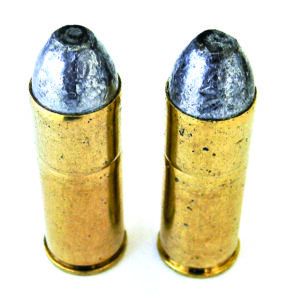 We tested the Super X swaged lead bullet load. Velocity in the revolver is 694 fps, 811 fps in the carbine. Penetration is 29 inches in the revolver and 38 inches in the carbine. For such a mild loading this is good penetration. While intended as a cowboy action load or a mild practice load you would be far from under gunned with this loading. A few words on penetration- standard swaged and cast cowboy loads track straight. This one tumbles midway, sometimes exiting the side of the water jug!
We tested the Super X swaged lead bullet load. Velocity in the revolver is 694 fps, 811 fps in the carbine. Penetration is 29 inches in the revolver and 38 inches in the carbine. For such a mild loading this is good penetration. While intended as a cowboy action load or a mild practice load you would be far from under gunned with this loading. A few words on penetration- standard swaged and cast cowboy loads track straight. This one tumbles midway, sometimes exiting the side of the water jug!
GUN TESTS GRADE (REVOLVER): B-
GUN TESTS GRADE (CARBINE): B-
Buffalo Bore 255-Grain Hard-Cast Outdoorsman 3E/20 45 Colt
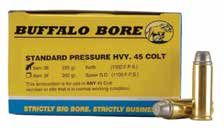 This is the most powerful load tested. In the handgun, velocity averaged 999 fps and in the carbine a strong 1160 fps. This is a standard-pressure loading that makes the most of the 45 Colt and offers real protection against dangerous animals. Our range fixtures and the “train” of water jugs we are able to set up are limited in depth. From either firearm the 255-grain bullet zipped through 54 inches of water. We feel very confident in this load. We rated it down based on overpenetration because home and personal defense are the primary criteria for this test. For big-animal defense against dangerous hogs or bears, nothing else comes close. As an all-round hunting load, this an excellent choice.
This is the most powerful load tested. In the handgun, velocity averaged 999 fps and in the carbine a strong 1160 fps. This is a standard-pressure loading that makes the most of the 45 Colt and offers real protection against dangerous animals. Our range fixtures and the “train” of water jugs we are able to set up are limited in depth. From either firearm the 255-grain bullet zipped through 54 inches of water. We feel very confident in this load. We rated it down based on overpenetration because home and personal defense are the primary criteria for this test. For big-animal defense against dangerous hogs or bears, nothing else comes close. As an all-round hunting load, this an excellent choice.
GUN TESTS GRADE (REVOLVER): B-
GUN TESTS GRADE (CARBINE): B-
Bottom Line
For personal defense and home defense, we would expect any of the 45 Colt loads to provide good wound ballistics. It would be foolish to use one of the high-penetration loads (Buffalo Bore 255-Grain Hard-Cast Outdoorsman 3E/20, Handload, Hornady 250-Grain XTP, SIG Sauer Elite V-Crown 230-Grain JHP E45LC1 in the revolver, Winchester Super-X 255-Grain Lead Round Nose X45CP2) for defense in a suburb, however, and we feel that one of the hollow-point loads is best. The Remington HTP 230-Grain JHP No. 28562, Winchester Super-X 225-Grain Silvertip X45CSHP2, Federal Champion 225-Grain Semi-Wadcutter Hollow Point C45LCA, and Winchester 225-Grain Defender S45XPDB are all excellent choices for use in the revolver.
In the carbine, the Remington HTP 230-Grain JHP fragments, which isn’t the worst thing for home defense, given that this is a lot of bullet flying around inside a target.
We do not like the SIG Sauer Elite V-Crown 230-Grain JHP in the revolver. Overpenetration and a lack of penetration were exhibited. In the carbine, the SIG load moved close to the top of the heap.
The only demerit for the Buffalo Bore 225-Grain Hard-Cast Semi-Wadcutter Hollow Point load is greater recoil in the revolver. Otherwise this loading offers the maximum wound potential in the revolver. For home defense, mild recoil and excellent expansion make it ideal in the carbine.
The Hornady 250-grain XTP is definitely an outdoors bullet based on its penetration and a lack of expansion. The non-expanding Winchester Super-X 255-Grain Lead Round Nose load, however, is a contrast to most low-velocity cowboy loads. The soft lead bullet has a reputation for tumbling, borne out in our testing to an extent. We would not feel undergunned with this load for home defense. For use in the field for defense against dangerous feral hogs or bears, the Buffalo Bore 255-grain SWC loading is an exceptional choice.
We did not test birdshot loads as thoroughly as we did the other loads. They are not suitable for any type of personal defense, but are well suited to clearing the garden of pests or taking out a dangerous reptile without a danger of missing or ricochet. CCI offers two types in 45 Colt chamberings.
The first is a plastic capsule filled with No. 9 birdshot. About 150 grains of shot is propelled at more than 900 fps. The other type is a No. 4 load, listed at 140 grains, that runs about 800 fps in the revolver. We had a limited supply so we could not test the No. 9 load in the carbine. To check penetration, we used a hardcover book as the target, firing the No. 9 load at 10 feet. That’s far enough for us to be comfortable shooting at a snake’s head — most of us like ample stand-off distance.
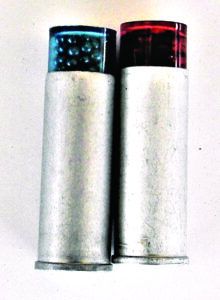
The pattern nearly covered the book cover in a pattern over 6 inches. Some of the small pellets missed altogether. Some were stopped in the book cover. A handful were found between the book cover, frontispiece, and lead page. Maximum penetration was the cover and three pages. This isn’t suitable for anything larger than a rat or small reptile, we think.
Number 4 shot was much more impressive. The pattern was comparable, with a bit more spread between the individual pellets. The book cover was perforated and the heavier pellets went on to penetrate more than 60 pages — and a trio of pellets stopped at 80 pages. This is significant penetration in paper, which is useful for simultaneously testing pattern and penetration. In the rifle, the pattern was about the same. Velocity must be greater because the No. 4 load out of the carbine penetrated 120 pages of paper. This would be an effective load on many vermin.
Considering the plastic containers holding the shot may be crushed in the tubular magazine of a lever gun, we would only load one shotshell at a time in the chamber of the rifle.
45 Colt Performance Data
| Bullet Weight (Grains) | Manufacturer, Brand, and Product Number | Average Velocity (fps) | Standard Deviation (fps) | Muzzle Energy (foot-pounds) | IPSC Power Factor | Average Accuracy (inches) | Expanded Width (inches) | Retained Weight (grains) | Retained Weight (percentage) | Penetration In Water (inches) | Gun Tests Grade |
|---|---|---|---|---|---|---|---|---|---|---|---|
| 225 | Buffalo Bore SWCHP | 990 | 14 | 490 | 223 | 3 | 0.84 | 224 | 100% | 24 | A |
| 225 | Buffalo Bore SWCHP (Carbine) | 1109 | 11 | 614 | 250 | 2 | 0.88 | 221 | 98% | 25 | A |
| 225 | Federal Champion SWCHP C45LCA | 837 | 39 | 350 | 188 | 3.1 | 0.7 | 224 | 100% | 24 | A |
| 225 | Federal Champion SWCHP C45LCA (Carbine) | 1022 | 25 | 522 | 230 | 2.45 | 0.454 | 180 | 80% | 22 | B |
| 225 | Winchester Super-X Silvertip X45CSHP2 | 798 | 26 | 318 | 180 | 2 | 0.68 | 225 | 100% | 22 | A |
| 225 | Winchester Super-X Silvertip X45CSHP2 (Carbine) | 990 | 13 | 490 | 223 | 1.5 | 0.54 | 170 | 76% | 26 | A- |
| 225 | Winchester Defender S45XPDB | 810 | 19 | 328 | 182 | 2 | 0.66 | 225 | 100% | 24 | A |
| 225 | Winchester Defender S45XPDB (Carbine) | 1104 | 17 | 609 | 248 | 1.3 | 0.58 | 210 | 93% | 24 | A |
| 230 | Remington HTP 28562 | 857 | 22 | 375 | 197 | 2.9 | 0.72 | 230 | 100% | 18 | A |
| 230 | Remington HTP 28562 (Carbine) | 1040 | 25 | 552 | 239 | 1.1 | fragments | 124 | 54% | 24 | B |
| 230 | SIG Sauer Elite V-Crown E45LC1 | 729 | 8 | 271 | 168 | 1.75 | 0.452 | 230 | 100% | 38 | B- |
| 230 | SIG Sauer Elite V-Crown E45LC1 (Carbine) | 889 | 14 | 403 | 204 | 1.2 | 0.8 | 230 | 100% | 18 | B+ |
| 250 | Hornady XTP Handload | 798 | 7 | 353 | 200 | 1.2 | 0.452 | 250 | 100% | 42 | B- |
| 250 | Hornady XTP Handload (Carbine) | 955 | 11 | 506 | 239 | 0.7 | 0.454 | 250 | 100% | 48 | B- |
| 255 | Buffalo Bore Hard-Cast Outdoorsman | 999 | 13 | 565 | 255 | 2 | 0.454 | 255 | 100% | 54 | B- |
| 255 | Buffalo Bore Hard-Cast Outdoorsman (Carbine) | 1160 | 14 | 762 | 296 | 1.75 | 0.454 | 255 | 100% | 54 | B- |
| 255 | Winchester Super-X LRN X45CP2 | 694 | 31 | 273 | 177 | 2.45 | 0.454 | 255 | 100% | 29 | B- |
| 255 | Winchester Super-X LRN X45CP2 (Carbine) | 855 | 28 | 414 | 218 | 2.00 | 0.454 | 255 | 100% | 38 | B- |

























That’s all great but in my area, 45 Colt bullets are harder to find then hen’s teeth…
Thanks for this insightful testing. I’ve loved the .45 Colt for as long as I can remember and own both a couple of SAA revolvers and a Uberti clone of the Winchester 1873 in .45 Colt caliber. I also reload myself so working up an effective home defense load will not be a problem. To date I’ve mainly used 250 grain lead round nose bullets, but I can certainly expand my loadings.